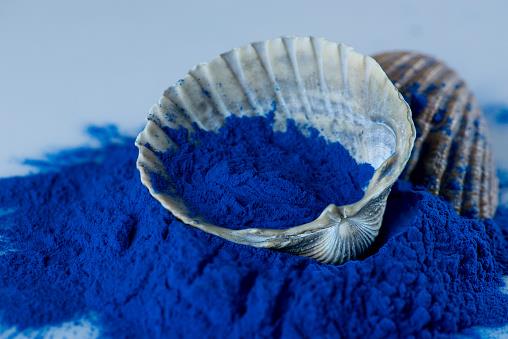1. What is phycocyanin?
Phycocyanin is a blue pigment extracted from spirulina and is a pure natural food coloring. Phycocyanin is also one of the rare pigment proteins in nature. It is not only bright in color, but also a kind of protein in itself. It is also a good nutritional raw material with rich functionality. As one of the few pigmented proteins in nature, it can provide a comprehensive range of amino acids with strong nutritional and health value. Therefore, it is widely used in food and beverage, cosmetics, medical care and other fields.

In Europe and the United States, phycocyanin is listed as a superfood and is a common smoothie ingredient. Because of its unique blue color and rich nutrition, smoothies made with phycocyanin are very popular on social platforms such as Instagram and Facebook.
At the same time, because of its fluorescent properties, it can be made into fluorescent reagents, probes, tracer substances, etc., which are used in the fields of clinical medicine, immunology and biology.
In recent years, studies have also shown that phycocyanin has functional activities such as antioxidant, anti-tumor, and anti-diabetes. It can be used as a pharmaceutical ingredient for medical care, and it is also an ideal photosensitizer without toxic side effects.
2. the extraction method of phycocyanin
Phycocyanin is extracted from Spirulina by mild physical methods such as centrifugation, concentration and filtration, and only water is added as an auxiliary throughout the process.
The whole extraction process is closed to avoid the mixing of contaminants. The extracted phycocyanin usually comes in powder or liquid form with other excipients added. (eg adding trehalose to make protein more stable, adding sodium citrate to adjust pH.)
Phycocyanin usually contains peptides and proteins (10-90%, dry weight, including proteins complexed with phycocyanin), carbohydrates and polysaccharides (1000 weight ≤ 65%), fat (dry weight < 1%), Fiber (<6% dry weight), mineral ash (<6% dry weight) and water (<6%).
3. Phycocyanin Specifications
Powder: Phycocyanin E6, E10, E18, M18, E25, E30, organic and other specifications are blue powder.
Liquid: Phycocyanin E3 is a blue honey-like liquid
4. The efficacy and application fields of phycocyanin
Food Colorants
Phycocyanin is a 100% water-soluble natural blue pigment protein that can be used in cold food, beverages, candies, jellies, dessert cakes, etc.
Makeup and Beauty
Phycocyanin is a collagen-like protein with anti-oxidant, moisturizing, anti-allergic, anti-inflammatory and freckle-removing effects, and makes skin care products present a beautiful ocean blue tone.
Medicine and Healthcare
Phycocyanin has the functions of delaying aging, anti-tumor, anti-radiation, improving immunity, and nourishing blood. In addition, it is also effective in anti-oxidation and anti-allergy.
Biochemical reagents
It can be used as some photodynamic research reagents in biology and cytology. Can also be used as a biochemical marker. Its fluorescence efficacy is 30 times that of ordinary fluorescein.
Crop fertilizer
Phycocyanin, a photosensitive protein, is a light-harvesting antenna in algal cells and has rich nutrients and a comprehensive amino acid composition. It can obviously promote the photosynthesis of crops, and at the same time make the crops have antiviral and antibacterial abilities.
Xi’an Lyphar was established in 2011, focusing on the extraction of phycocyanin, and has rich experience in extraction, research and development and product application. A food safety system that guarantees products from the source of raw materials to the hands of consumers and the quality of products is guaranteed after the sale.
5. Dosage of Phycocyanin
Food intake
The amount of phycocyanin ingested from food and from other dietary sources including food ingredients, dietary supplements and coatings for dietary supplements is shown in the International Codex Committee on Food Additives document to a 60 kg adult 190 mg/kg (i.e. 11.4g), or 650 mg/kg (i.e. 9.75g) for a 15kg child. The committee concluded that this intake did not pose a health concern. In the European Union, phycocyanin is used as a color food raw material and is used in unlimited quantities.
App additions
Phycocyanin is used as a color food raw material in Europe and can be used in unlimited quantities. Therefore, in practical applications, it can be added on demand according to the final required color depth of the product.
According to the years of market experience of Xi’an Lyphar to achieve the final effect of light blue, only a small amount of addition is required: such as one-thousandth of E18. To increase the depth of blue, increase the amount added.
